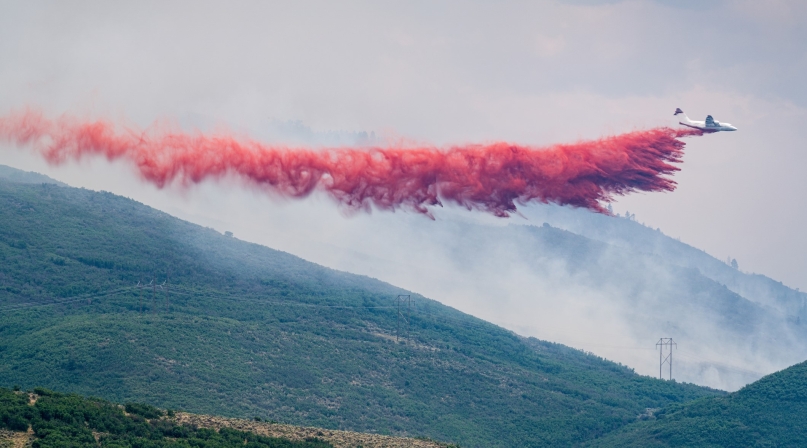Wildfire commission report expands beyond suppression tactics

Key Takeaways
When Bill Cox worked as a volunteer firefighter in his 20s and 30s, he’d battle one or two structure fires a year versus 30 wildland fires.
Now as a Rich County, Utah commissioner, he sees wildland fires grow in size and frequency. At the same time, finding people to fight those fires, like his younger self, gets harder and harder. It’s something he hopes federal legislation might change.
“It’s hard to recruit people for a seasonal job without benefits,” he said of being a first responder. “We have to figure out how to increase the workforce and keep them stable and have this be a career. This isn’t something a teacher can do on summer break.
“It’s not fun, but it’s critical,” he said. “Those areas where those guys work is critical in stopping the fire from advancing to different areas.”
Learn more
ON FIRE: The Report of the Wildland Fire Mitigation and Management Commission
Cox, along with Coconino County, Ariz. Deputy County Manager Lucinda Andreani, represented county governments on the Wildland Fire Mitigation and Management Commission, a 50-member effort coordinated by the departments of Agriculture and the Interior and the Federal Emergency Management Agency.
“Frankly, in any form of disaster — wildfire, tornadoes, hurricanes — it really typically is counties that are managing the post-disaster, during and after the disasters and the recovery processes,” Andreani said. “Our seat at that table was crucial because we sustain those impacts, we work with our constituents that have the impacts, and so it was a really important opportunity.”
The commission’s report, released in late 2023, offered 148 recommendations to Congress, and the scope of that work demonstrated to Andreani that this was different and more consequential than previous intergovernmental efforts to address wildland fire policy.
“There really had been very little discussion about mitigating wildfire — on forest restoration, forest thinning and other practices — to reduce the threat of catastrophic wildfire and then certainly very little national discussion about post- wildfire recovery,” she said.
“The fact that [the commission’s report] did cover all of that and wasn’t just solely dominated or exclusively focused on suppression, that was kind of a landmark situation. The other aspects now are having a lot of impact. You’re looking at the full cycle now.”
She noted that members of Congress have already taken notice of the report’s variety and proactive recommendations.
Cox drew attention to the aging aircraft that are crucial to wildland firefighting and the challenges contractors face with uncertainty when assessing when to purchase new aircraft. He contributed to a second report on aerial equipment strategy.
“It’s gotten to the point now where we’ll have fires going around the nation in four or five different places and they’re all big fires, so there are a limited amount of resources, aviation resources, to be spread out over into all those particular fires,” he said. “All of a sudden, you have to prioritize a fire as to what resources you put on it.”
A veteran of managing Coconino County’s direction through three major wildfires, Andreani said the commission’s work was a chance to address silos in federal policy and encourage cross-jurisdictional appropriations.
“It becomes problematic where you’re trying to effectuate recovery efforts that may be on state land, federal land and private land,” she said. “How do you take those blinders off?”
She also noted the commission recognized what Coconino County long had known — while FEMA considers wildfires a one-time event, their environmental consequences open the doors for repeated flooding, given Arizona’s meteorological patterns.
“We had a lot of discussions around how you take these programs that are designed for certain types of disasters and then modify them so that they apply appropriately in a wildfire situation,” she said.
Participation was taxing — long days on video calls, but Cox said the result renewed his confidence in government.
“If Congress could work like the commission, get the right and the left out of it and just look at the solution and then work through that solution,” they could accomplish a lot, he said. “We can look at these accomplishments and say we did it while keeping politics out of it.”
Related News

U.S. House of Representatives passes SPEED Act and other permitting reform bills
On December 18, the U.S. House of Representatives passed the SPEED Act (H.R. 4776). The SPEED Act would strengthen county involvement in decision-making and make needed commonsense reforms to the federal environmental review process.

House Natural Resources Committee advances the Endangered Species Act Amendments Act of 2025
On December 17, the House Natural Resources Committee advanced the Endangered Species Act (ESA) Amendments Act of 2025 (H.R. 1897). The version passed by the committee adopted several changes from the initial bill and would address key county concerns by improving the implementation of the ESA. The legislation now awaits a floor vote before the whole U.S. House of Representatives.

County Countdown – Dec. 15, 2025
Every other week, NACo's County Countdown reviews top federal policy advocacy items with an eye towards counties and the intergovernmental partnership.
